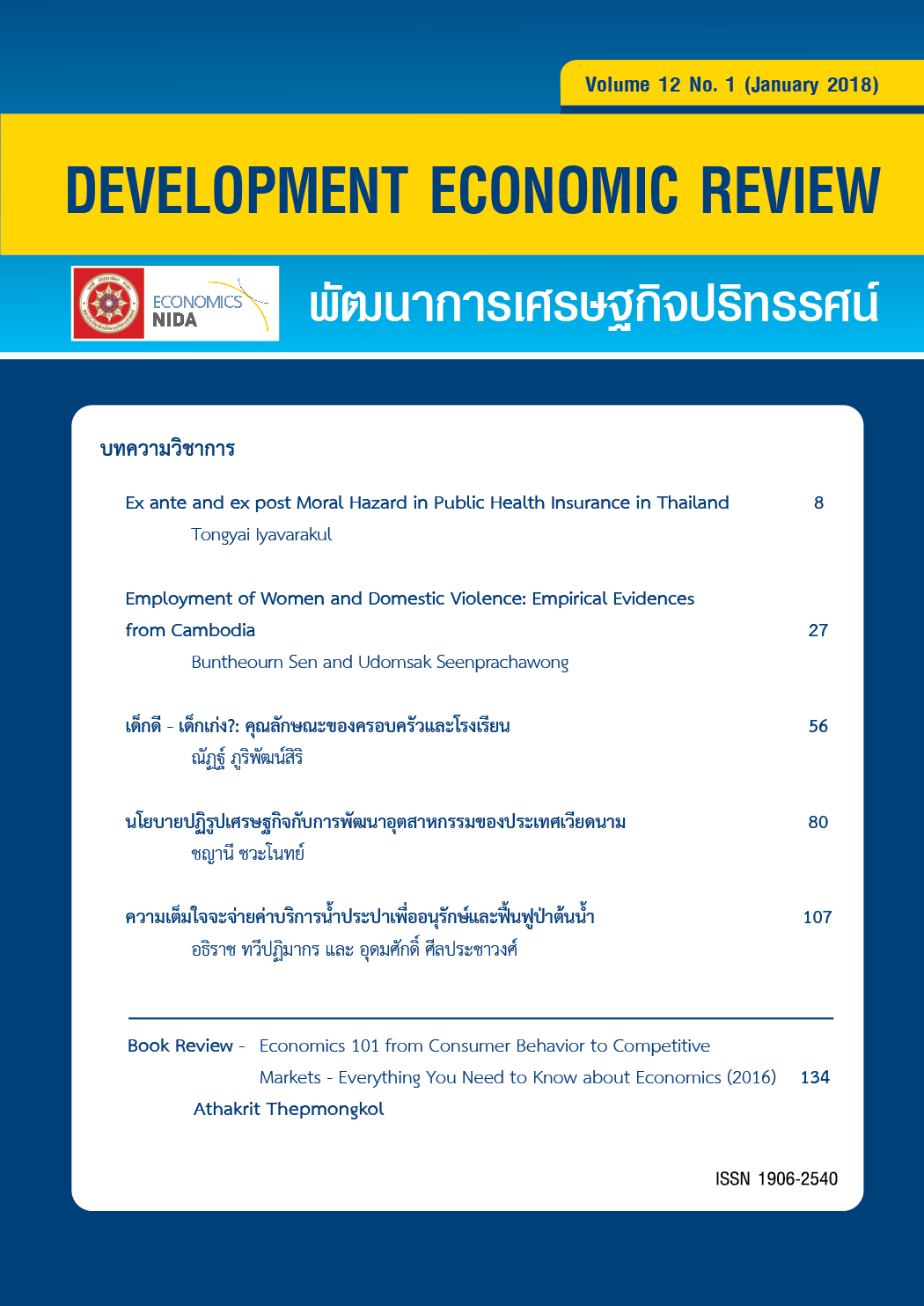Ex ante and Ex post Moral Hazard in Public HealthInsurance in Thailand
Keywords:
Ex ante Moral Hazard, ex post Moral Hazard, Universal Coverage Program, Copayment, Ordered Probit with Selection ModelAbstract
Despite the much-acclaimed success of the Universal Coverage program that ensures virtually everyone in Thailand of gaining access to health insurance, there has recently been a fervent public debate over the possibility that the program may reduce prevention efforts of risky behaviors (ex ante moral hazard) or increase unnecessary healthcare utilization of the beneficiary (ex post moral hazard). This paper is the first empirical study on this issue in Thailand. Individual-level data from the Supplement Household Socioeconomic Survey in 2007 were used to investigate the effect on healthcare utilization of three different public health insurance programs: Universal Coverage (UC), Civil Servant Medical Benefits (CSMB), and Social Security (SS).The contribution of this study is two-fold. From a theoretical perspective, it is a pioneering empirical study that simultaneously estimates the effect of health insurance on both ex ante and ex post moral hazard. From a policy perspective, it provides the first empirical evidence that sheds light on the nature of moral hazard in public health insurance in Thailand. In particular, the estimation results show that the UC program is the only public health insurance program that does not exhibit any type of moral hazard. The recent proposed copayment of beneficiaries under the UC program as a preventive measure of moral hazard is therefore unnecessary and likely comes at a cost of reducing access to health insurance of the poor.
References
129-142.
Bhattacharya, J., & Packalen, M. (2008). The other ex-ante moral hazard in health. NBER
Working Paper Series 13863. National Bureau of Economic Research, Journal of
Health Economics, 31 (1), 135-146.
Cameron, A. C., Trivedi, P. K., Milne, F., & Piggott, J. (1988). A micro-econometric model of
the demand for health care and health insurance in Australia. Review of Economic
Studies, 55(1), 85-106.
Card, D., Dobkin, C., & Maestas, N. (2008). The impact of nearly universal insurance coverage
on health care utilization: evidence from Medicare. American Economic Review, 98(5),
2242-2258.
Cherkin, D. C., Grothaus, L., & Wagner, E. H. (1989). The effect of office visit copayments on
utilization in a health maintenance organization. Medical Care, 27(11), 1036-1045.
Coulson, N. E., Terza, J. V., Neslusan, C. A., & Stuart, B. C. (1995). Estimating the moral
hazard effect of supplemental medical insurance in the demand for prescription drugs
by the elderly. American Economic Review, 85(2), 122-126.
Dave, D., & Kaestner, R. (2009). Health insurance and ex-ante moral hazard: evidence from
Medicare. International Journal of Health Care Finance and Economics, 9(4), 367-390.
De Luca, G, & Perotti, V. (2011). Estimation of ordered response models with sample selection.
Stata Journal, 11(2), 213-239.
Greene, W. (2003). Econometric Analysis. New York: Prentice Hall.
Harmon, C., & Nolan, B. (2001). Health insurance and health services utilization in Ireland.
Health Economics, 10(2), 135-145.
Harris, B. L., Stergachis, A., & Ried, L. D. (1990). The effect of drug copayments on utilization
and cost of pharmaceuticals in a health maintenance organization. Medical Care,
28(10), 907-917.
Hughes, D. & McGuire, A. (1995). Patient charges and the utilization of NHS prescription medicines.
Health Economics, 4(3), 213-220.
Keeler, E. B., & Rolph, J. E. (1988). The demand for episodes of treatment in the health insurance
experiment. Journal of Health Economics, 7(4), 337-367.
Kenkel, D. S. (2000). Prevention. In A. Culyer, & J. Newhouse (Eds.), Handbook of Health
Economics (pp. 1675-1720). North-Holland, NH: Elsevier.
Klick, J., & Stratmann, T. (2007). Diabetes treatments and moral hazard. Journal of Law and
Economics, 50(3), 519-138.
Lillard, L. A., Manning, W. G. et al. (1986). Preventive medical care: Standards, usage, and
efficacy. Rand Publication, R-3266-HCFA, Santa Monica, CA.
Manning, W. G., Newhouse, J., Duan, N. et al. (1987). Health insurance and the demand for
Medical Care: Evidence from a randomized experiment. American Economic Review,
77(3), 251-277.
Ministry of Public Health of Thailand. (2012). Proclamation on the exemption of copayment.
National Health Security Office of Thailand (2013). Annual Report 2011. Bangkok: Sahamitra
Printing and Publishing.
Newhouse, J. P., Rolph, J. E., & Murphy, M. (1980). The effect of deductibles on the demand
for medical care services. Journal of the American Statistical Association, 75(371),
525-533.
Roddy, P. C., Wallen, J., & Meyers, S. M. (1986). Cost sharing and use of health services: The
United Mine Workers of America health plan. Medical Care, 24(9), 873-877.
Scitovsky, A. A., & Snyder, N. M. (1972). Effect of coinsurance on use of physician services.
Social Security Bulletin, 35(6), 3-19.
Shin, E. H., & Lim, J. Y. (2010). De-mystifying the inconvenient truth: Does ex post moral hazard
indeed exist in Korean private health insurance market?. Hitotsubashi Journal of
Economics, 51(2), 129-147.
Thailand Development Research Institute (2010). Social investment under changing environments
and adjustments towards knowledge based economy, Bangkok: Thailand Development
Research Institute.
Wooldridge, J. (2010). Econometric analysis of cross sectional and panel data. Cambridge:
MIT Press.
Yilma, Z., Kempen, L., & de Hoop T. (2012). A perverse ‘net’ effect? Health insurance and
ex-ante moral hazard in Ghana. Social Science & Medicine, 75(1), 138-147.
Zweifel, P. & Manning, G. (2000). Moral hazard and consumer incentives in health care. In A.
Culyer, & J. Newhouse (Eds.), Handbook of Health Economics (pp. 409-459).
North-Holland, NH: Elsevier.
Downloads
Published
Issue
Section
License
Copyright to published manuscripts becomes the property of the Graduate School of Development Economics, National Institute of Development Administration. Reproduction of all or part of a Development Economic Review (DER) article by anyone, excluding author(s), is prohibited, unless receiving our permission.
Disclaimer: Opinions expressed in articles published in this journal are those of the author (s) and do nto necessarily represent opinions of the Graduate School of Development Economics, National Institute of Development Administration. Trade and proprietary names are only for identification and not constitute our endorsement.


